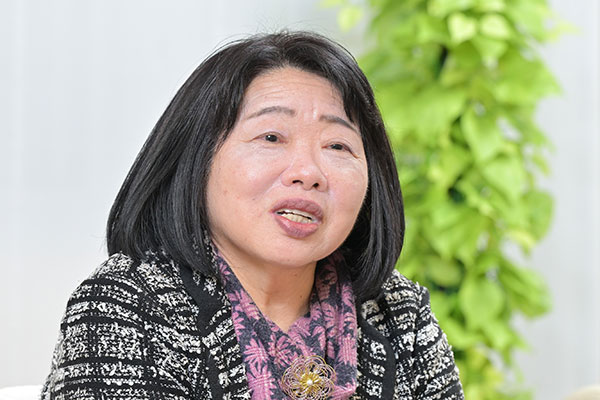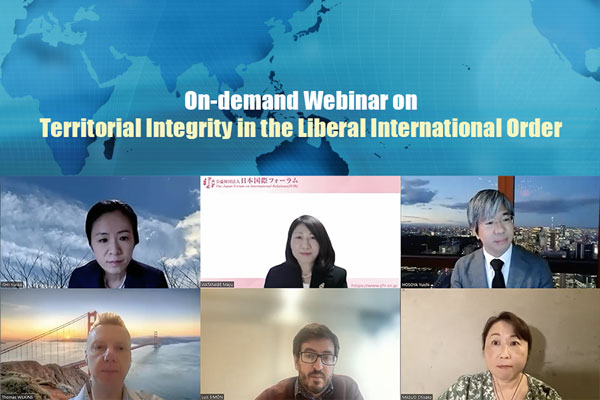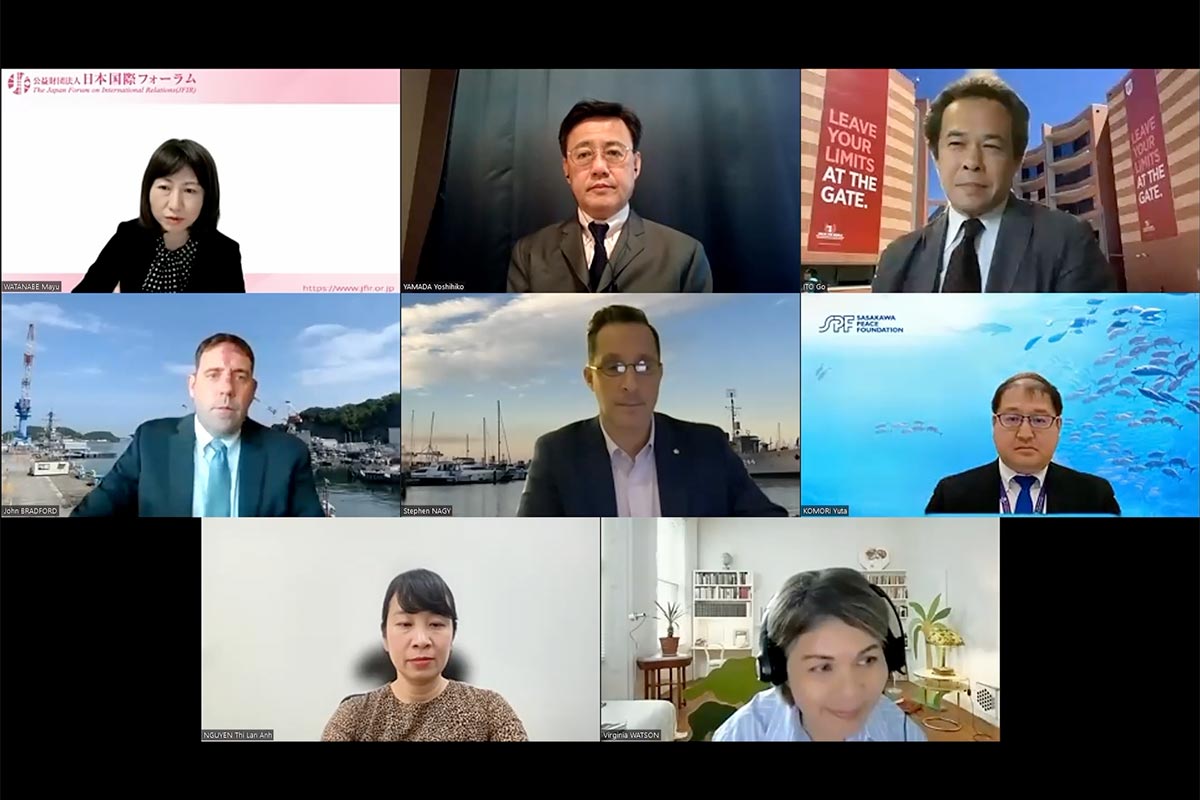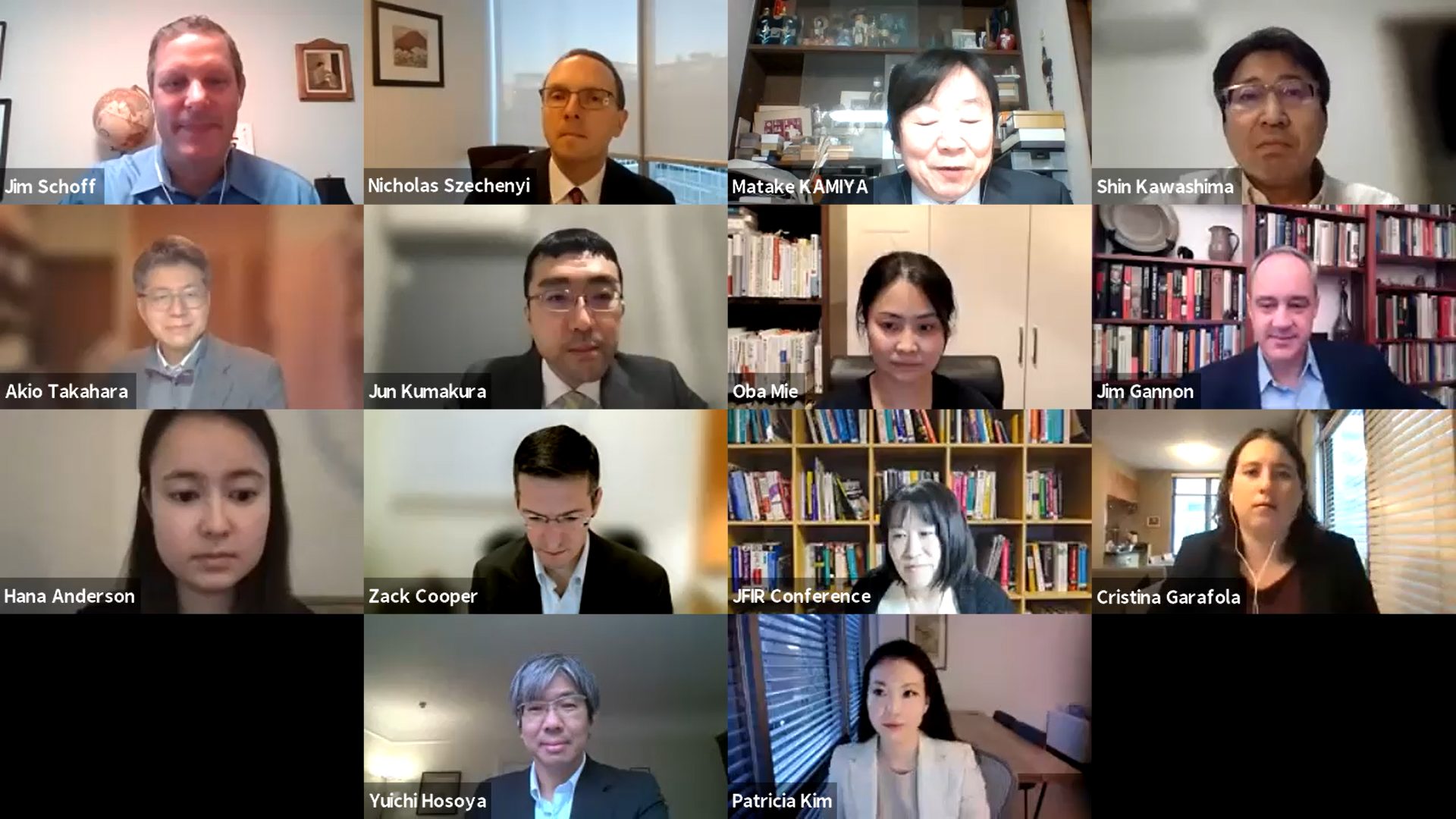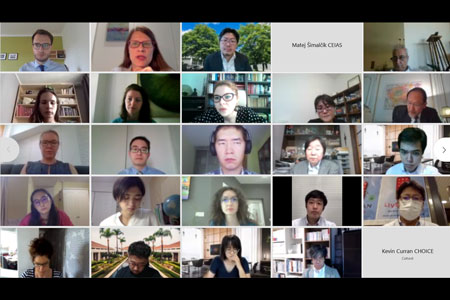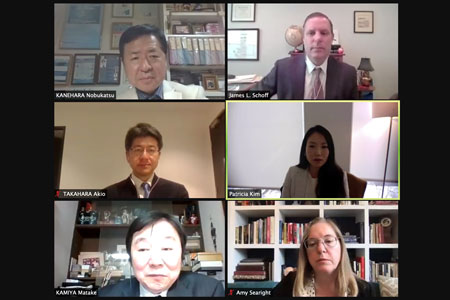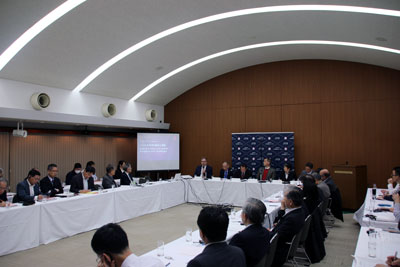Featured
JFIR Commentary
"JFIR Commentary" introduces news analyses and opinions in Japan on Japan's position in the international community, but they do not represent the views of JFIR as an institution.
April 03,2024
The “Blue Pacific” and U.S.–China Confrontation
Since the mid 2010s, the Pacific Islands Forum, a regional organization, has been attempting to establish a regional order named the “Blue Pacific,” in Oceania, which has garnered attention as one of the focal points in the ongoing U.S.-China confrontation. The likely background to this is the transformation of the regional order in Oceania due to factors internal and external to the region. In the late 1990s, disagreements over climate change caused a rift between the Pacific Island Countries and Australia and New Zealand, causing the cohesive power of the Pacific Islands Forum, which comprises these countries, to decline. Simultaneously, as the regional order, which had been based on cooperation between the Pacific Island countries, Australia, and New Zealand through the Pacific Islands Forum, was shaken, China approached the former, triggering further changes. China’s efforts to expand its influence in the Pacific Island Countries through economic assistance and military cooperation has made the regional order in Oceania even more fluid. Against this backdrop, the “2050 Strategy for the Blue Pacific Continent,” announced by the Pacific Islands Forum in 2019, asserts that the Pacific Islands are the custodians of the “Blue Pacific Continent.” It aims to promote regional cooperation in the seven areas of political leadership and regionalism, people-centered development, peace and security, resources and economic development, climate change and disasters, ocean and environment, and technology and connectivity. The inclusion of climate change and natural disasters a s well as other claims made by the Pacific Island Countries in the “Blue Pacific” may reflect a heightened diplomatic stance of these countries toward Australia and New Zealand due to China’s approach. Further, for Australia and New Zealand, the “Blue Pacific” seems to have been intended as a means to mend the rift over climate change with the Pacific Island Countries regaining influence in the face of China’s emergence. It could be said that such opportunities for Pacific Island countries made apparent in the “Blue Pacific,” are being extended by further action from China. In April 2022, China signed a security agreement with the Solomon Islands, while in May it attempted to conclude a regional security agreement with ten Pacific Island Countries with which it has diplomatic relations. Whilst the latter attempt was unsuccessful, the United States, Japan, Australia, New Zealand, and the United Kingdom, becoming more wary of Chinese actions, formed the “Partners in the Blue Pacific” in June of the same year, thus clarifying their stance against China through support for the “Blue Pacific” (subsequently, Canada, Germany, and South Korea also joined this group). In September of the same year, the United States held a summit meeting with Pacific Island Countries, adopted the “Declaration on U.S. Pacific Partnership,” and announced the “Pacific Partnership Strategy,” which calls for support for the “Blue Pacific.” China’s efforts to expand its influence have motivated Western assistance to the Pacific Island Countries. Meanwhile, the risks for the Pacific Island Countries should be pointed out. For example, while Western countries have framed the “Blue Pacific” as a strategic part of the “Indo-Pacific” to counter China, a cautious view persists among Pacific Island Countries that they will be drawn into the U.S.-China confrontation. As China attempts to expand its influence and Western countries respond by increasing their support for the “Blue Pacific,” Pacific Island Countries become more likely to get caught in the vortex of U.S.-China confrontation. It is no easy task for the Pacific Island Countries, which lack diplomatic power, to expand their opportunities while distancing themselves from the U.S.-China confrontation.
February 19,2024
Why Has Sanctioning Russia Been Ineffective? An Examination of How to Improve the Sanctions Against Russia
February 24, 2024 marks the third year of the Russo-Ukrainian War that started with the Russian full invasion of Ukraine. As the war reached a stalemate, the return of the territory taken from Ukraine seemed increasingly difficult. The Ukrainian counteroffensive stalled due to delays in military aid from the Western powers and the lack of weakening in Russia’s military might. Although US President Joe Biden’s announcement of “unprecedented sanctions” with great fanfare, sanctions against Russia, designed to freeze its ability to fund the war, have not produced decisive results. This paper overviews the sanctions that have been in place against Russia for the last two years, examines the reasons for their ineffectiveness, and discusses how to improve them. 1. Long-Awaited Secondary Sanctions US military aid to Ukraine is in limbo, and the same can be said for the sanctions against Russia. On December 22, 2023, President Biden announced the implementation of economic sanctions that would close the US financial markets to all financial institutions worldwide engaged in foreign trade with Russia to halt Russia’s procurement of weapons from third countries. With this move, the White House put its might behind the first secondary sanctions related to the Russian war in Ukraine. However, Russia began importing weapons from North Korea, which paid no heed to the US sanctions. Russia has imported military related goods from countries in Central Asia and the Middle East, but shutting out the small financial institutions of those countries, which are the main centers of Russia’s transit trade, was almost completely ineffective. Although the most effective sanctions would be those imposed against financial institutions in China, which expands its trade relationship with Russia, such sanctions are unlikely due to the enormous negative impact they would have on the world economy. Under these circumstances, the effectiveness of the secondary sanctions is being called into question. Given that military aid has stalled due to opposition in US Congress, it has strengthened one’s suspicion that the aim is to make an appeal for “strengthening sanctions,” which can be done on presidential authority alone. In spite of the economic and financial sanctions the United States has imposed, along with the G7 countries and the European Union (EU), the Russian economy has not suffered major damage that would prevent it from continuing to fund the war. Supplies of Russian crude oil to China, India, and Turkey have increased, and although Russian financial institutions have been barred from participation in the Society for Worldwide Interbank Financial Telecommunication (SWIFT), Russian trade has continued due to increases in transactions using currencies other than the US dollar, a phenomenon which began in the early 2010s. Russian assets, including instruments such as foreign currency reserves amounting to 300 billion US dollars have been frozen, and although the ruble experienced a temporary crash, it recovered as a result of intervention by the Central Bank of the Russian Federation. Naturally, the Russian economy has experienced a long-term slump as a result of being cut off from the US economy, which has led Western corporations—which have the most advanced technologies—to pull out of Russia. Nevertheless, largely unaffected energy exports continue to facilitate weapons production. Ukrainian estimates indicate that although Russia produced forty long-range missiles per month two years ago, current production has expanded to 100 missiles per month. They also claim that Russian soldiers’ pay is three times the monthly average. The International Monetary Fund (IMF) announced that the Russian economy grew 2.2 percent in 2023, partially due to wartime demand and predicts that the Russian economy will grow 2.6 percent in 2024. Russian President Vladimir Putin’s statement that “the sanctions against Russia have failed” was not mistaken. 2. The “Third Country Trade Loophole” One of the factors supporting Russia’s war against Ukraine are the military supplies entering the country via transit countries. According to a Ukrainian think tank, 30 percent of the machine parts imported into Russia in 2023 that can be diverted to military use were manufactured in Western countries, including Japan. Another think tank stated that 72 percent of the components used in Russian drones and missiles were manufactured by US corporations. Why do these materials continue to flow into Russia in spite of the trade embargo? The materials are believed to enter Russia via countries such as China, Turkey, the United Arab Emirates (UAE), Kazakhstan, Uzbekistan, and Morocco. A New York Times article based on an analysis of 4,200 communications from Russian corporations reported that telecommunications and reconnaissance equipment, semiconductors, drones, and other types of equipment are being sent from China to Russia via Morocco’s Tanger-Med port. The article indicated that supplies equivalent to 10 million US dollars reach Russia via the Tanger-Med port per year. Moreover, although 27 percent of the semiconductors imported into Russia originated in China (including Hong Kong) prior to the war, since the war started, that figure has sharply increased to 85 percent. It has been reported that, in the past, Russia used semiconductors and other components taken from washing machines and other types of machinery made in Europe and imported via countries such as Kazakhstan for weapons construction. This fact used to be for jokes about the severity of Russia’s situation. However, Russia is now said to be obtaining the most advanced devices—including artificial intelligence semiconductors—manufactured by companies such as Nvidia, Intel, and Google. Presently, two years after the start of the invasion, the entire Ukrainian territory is being brutally attacked by ballistic missiles and drones, and Russia has retained the land it obtained from Ukraine. One of the reasons of Russia’s military strength is its ability to get materials necessary to build weapons. An executive order signed by President Biden on December 22 is to impose sanctions barring financial institutions involved in the export of military supplies to Russia via third countries from US financial markets. Previously, only Russian importers and exporters were sanctioned, but from now on, financial institutions in third countries are also to be targeted. As aforementioned case of Morocco shows, if a Moroccan bank is involved in the transshipment of cargo at Moroccan ports during the exportation of semiconductors from China to Russia, the Moroccan financial institution will be sanctioned and lose the ability to use US dollars. Since many more financial institutions are involved in trade via third countries, the secondary sanction is designed to have numerous other targets and achieve the aim of stopping the targeted type of trade. Secondary sanctions on Iran since 2007 are thought to be a major success, and led to the decision to implement the current secondary sanctions on Russia. According to the US Treasury Department, the military supplies the sanctions are targeting include a wide range of basic components that can be used for everything from advanced equipment compilation to basic weapons production, for example, machinery, machine parts, semiconductor components such as silicon wafers, machinery used in the production of semiconductors, testing equipment, propellants, lubricating oils, optical equipment, navigation-related equipment, and bearings. The drafter of the sanctions, Deputy Secretary of the Treasury Wally Adeyemo, stated that banks will be targeted by these sanctions even if they were unaware of the fact that the money transfers were for the purpose of military supplies bound for Russia. This is severe indeed, because banks are now required to examine the details of each money transfer to determine if the payment is related to items on the abovementioned US Treasury Department list. The US administration is demanding that banks simply abide by the obligation to make appropriate efforts, but from the banks’ perspective, the requirement significantly increases the burden placed on them. Most European and Japanese banks have already withdrawn from all business related to exports bound for Russia, and US government officials have stated that there are no reports of Western banks involved in such exports. 3. Are Sanctions Against China Possible? There are many Chinese banks which are very active in international business. Given that some of Chinese banks are believed to be involved in the exportation of military supplies to Russia, they should be targeted by sanctions. However, US government officials’ comments regarding this issue have been inconsistent. The secondary sanctions that target financial institutions worldwide are the most severe of all US-imposed sanctions. The imposition of such severe sanctions on any bank would be tantamount to a death sentence since most of the world’s trade and investment is conducted using US dollars. The decline of the United States has long been predicted, but the power of the US dollar as a key currency is overwhelming in the financial world. Bur at a press briefing on these sanctions, a US government official stated that the US government would rather not impose them and further stated that it would like banks to conduct their own surveys and cease handling regarding Russian military supplies. There is no mistaking that removing banks in China, the UAE, Turkey, and other countries from the US dollar financial system would have a major effect on the global economy. However, the comment gives a glimpse at the lack of enthusiasm in the United States that the Russian war against Ukraine has repeatedly revealed. Prior to the Russian invasion of Ukraine, America made it clear that “the US military would not be sent” to Ukraine. Subsequent to this declaration, the provision of weapons to Ukraine was also delayed due to “fears that [such a move] would lead to nuclear war.” These facts make the United States’ lack of enthusiasm apparent. In particular, given the endless sources of tension with China, including high tariffs, restrictions on the export of cutting-edge technologies, and the Taiwan issue, the United States would like to keep to a minimum the number of matters being disputed with China. Consequently, if possible, the US would avoid imposing sanctions on Chinese financial institutions, which would negatively impact the global economy. In the past, the United States sanctioned senior members of Chinese communist party in response to its suppression of both the democracy movement in Hong Kong and the human rights of Muslims in the Xinjiang Uyghur Autonomous Region, but so far, America has refrained from imposing full-scale sanctions on Chinese financial institutions. If the world’s second largest economy’s financial institutions were removed from the US dollar system, the enormous shock that would spread throughout the global economy would not be beneficial to US interests. The basis of the current US policy toward China is the so-called “small yard, high fence” approach that targets only advanced technologies, and financial sanctions with a worldwide impact would hardly be “small.” If the US continues to be reluctant to impose secondary sanctions on financial institutions in China and other countries, Biden’s “unprecedented sanctions” will never produce significant results. Russia utilizes the loopholes in trade with third countries, and China plays a key role to facilitate the trade with Russia. The lack of any punishment of China in connection with the Ukraine war shows America’s weakness and Russia’s strength. 4. Russia’s Meticulous Preparations President Putin of Russia has worked hard in building a nation that is sufficiently strong to withstand economic sanctions. His long-lasting efforts have clearly paid off. Putin has displayed his antagonism toward the United States and Europe ever since a speech he delivered in 2007, in which he strongly criticized the expansion of the North Atlantic Treaty Organization (NATO). The United States, which believed that Russia had been moving toward a Western-style democratic form of government, was surprised by his hostile statement. Then he moved quickly to take actions. In 2008, Russia invaded Georgia, a country that had been increasingly oriented toward the West. Russia began increasing energy exports to Asia. It built a series of natural gas pipelines to China “Power of Siberia,” and started operations of energy projects “Sakhalin-I” and “Sakhalin-II” as part of its attempts to have close energy ties with Asian countries and distance itself from the United States and Europe. Prior to this, in 2004, Russia’s border demarcation negotiations with China concluded, forming the basis for the current preliminary alliance between the two countries. Russia has compensated for the consequences of its invasion of Ukraine through exports to China, India, and Turkey that replaced the exports to European countries, but the foundation for this move was laid much earlier. In the wake of the Ukraine war, sanctions leveraging access to the US dollar, such as financial sanctions and the recently approved secondary sanctions, have attracted a great deal of attention, but Putin was prepared for such moves. He previously spoke forcefully about “danger of the world economy falling victim to the monopoly of the US dollar,” and in 2018, Russia sold enormous amounts of its US bonds, drastically reducing its currency reserves from 46 percent at the beginning of the year to 23 percent. The total currency reserves remained unchanged, but instead of US dollars, Russia increased its holdings of gold, euros, and renminbi. Moreover, it is estimated more than half of Russia’s US dollar currency reserves in the form of “cash” are held in countries other than the United States. This was used as a method to prevent the currency from being frozen due to US financial sanctions. Russia also rapidly shifted the currency it uses to settle its trade from the US dollar to the euro, renminbi, ruble, and other currencies. In the early 2010s, US dollars were used to settle over 90 percent of Russia’s trade accounts with China, a major trading partner, but in 2020, the use of US dollars was drastically reduced to around 10 percent of exports and 60 percent of imports. Furthermore, the percentage of export accounts with the EU that were settled using US dollars was also reduced from 70 percent to 40 percent, and the percentage used to pay for imports was reduced from just under 30 percent to just under 20 percent. Payments in euro, renminbi, and rubles are on the increase. In November 2014, Russia initiated a global financial messaging system known as the System for Transfer of Financial Messages (SPFS) in opposition to SWIFT. The aim of this move was to create a system that would allow international money transfers that could not be traced by the United States, as America has been monitoring SWIFT ever since the September 11 attacks. Initially, the scale of SPFS was nowhere near that of SWIFT. However, Putin undoubtedly implemented SPFS early on to reduce the effect of decisive sanctions imposed by the United States and Europe to a minimum. Russia is not the only country that made such preparations. China approached BRICS and the Persian Gulf nations for discussions with the offer of settling a variety of trade accounts using the renminbi. In October 2015, China initiated a global financial messaging system for the renminbi known as the Cross-Border Interbank Payment System (CIPS). Although only 20 banks initially utilized this system, that number has increased to 1,300 banks, and its daily volume, which is mainly concentrated in Asia, Africa, and the Middle East, has increased ten-fold to the equivalent of 46 billion US dollars. Although CIPS can hardly be compared to SWIFT, which boasts a daily volume of 5 trillion US dollars, China’s intention to counter US financial sanctions and challenge the US dollar’s hegemony is unmistakable. The issuance of digital renminbi currency is another attempt to avoid US monitoring and sanctions. 5. A Game of Cat and Mouse How will Russia counter the initial announcement of the secondary sanctions? Based on the ways that Russia has previously outmaneuvered sanctions, several possibilities come to mind. For example, beginning in December 2022, the international sale of Russian crude oil for more than 60 US dollars per barrel was prevented due to a price cap adopted by Japan, the United States, and the nations of Europe. Russia has gotten around to avoid the price cap by strengthening ties with other countries. According to the Finnish think tank CREA, in 2023, Russia sold to India two to three times the amount of oil it had sold to that country in the previous year. The same is true for China and Turkey. These countries then refined Russian crude oil and sold the resulting petroleum products to the nations of Europe. In those sales Russian crude oil was often purchased around 70 US dollars or more per barrel, which were violations of the price cap, there were only a few cases in which the violators were detected and charged. Traders in oil business in those countries simply don’t heed the price cap rule. Similarly, Russia will likely continue importing military supplies from third countries through financial institutions with no relation to the United States. Small banks of the third countries are little affected by the United States’ secondary sanctions because they are unlikely to engage in business in America or settle accounts using US dollars. In spite of the variety of sanctions that have been imposed on Russia, including the freezing of its assets, restrictions on its oil exports, being cut off from the advanced technologies and military supplies, and being subjected to financial sanctions, Russia has demonstrated use of a variety of loopholes and minimize any impact. Countries in the “anti-American coalition,” including Iran, North Korea, Venezuela, and China, among others, have learned these techniques from Russia and will use them to blunt the effectiveness of any future US sanctions. These countries are also investing efforts into creating global financial systems that are not dependent on the US dollar to elude US sanctions. This was even discussed at last year’s BRICS summit. Dmitri Trenin, a professor at Russia’s National Research University Higher School of Economics, stated that “For China and Russia, on whom US sanctions have been placed, the most important thing is the creation of a global financial payment system via BRICS that is not dependent upon the US dollar. The United States, which uses the dollar like a weapon against countries that oppose it, will eventually completely demolish its own economic position.” There is a possibility that this will actually come to pass. An effective strategy for expelling Russia from Ukraine would be the provision of support to the Ukrainian army, whose soldiers directly encounter the Russians on the battlefield. However, because public opinion in the United States is focused on domestic issues and the Republican Party is unwilling to cooperate with the Democratic Biden administration, the budget allotted to such support has been exhausted. There is certainly a perception that the secondary sanctions, which are the easier option to implement. Because sanctions require only the president’s signature, but the provision of meaningful support to Ukraine has to be passed in US Congress, which is uncertain. This seems to portend America’s lack of determination to lead the liberal camp and the decline of its hegemony. 6. Making Sanctions Effective We cannot allow the war in Ukraine to end with a Russian victory. Thus, it is necessary to maintain and bolster the sanctions, as well as lasting military support to Ukraine. Below is a list of ways to improve the sanctions’ effectiveness. The first is to avoid creating any further sense of solidarity among the members of the “anti-sanction coalition” that aids Russia. Central to this is stopping China from supporting Russia above and beyond what has already been done by imposing secondary sanctions against Chinese financial institutions. Denying huge Chinese banks access to the US dollar economy will affect the world economy. This can be avoided by focusing on small to mid-sized local institutions. The sanctioning of small and mid-sized institutions would have a sufficient deterrent effect to curtail China’s support of Russia as a whole, including support from major Chinese banks. The next strategy is strengthening sanctions on oil and natural gas, the revenue from which is funding Russia’s war effort. Monitoring and punitive measures associated with the price cap implemented in December 2022 on Russian crude oil trade that limits the price of a barrel of oil to under 60 US dollars have been insufficiently implemented. Import prices must be strictly reported, and a mechanism that will impose sanctions on those who do not abide by the price cap is needed. Additionally, Europe continues to purchase large amounts of natural gas from Russia, and its nations should reduce these purchases. Finally, bolstering monitoring of corporations of G7 and other western countries is necessary. Those corporations and the affiliated companies they established in third countries have to be prevented from exporting weapons-related technologies to Russia. The Foreign Direct Product Rule (FDPR), which prohibits the undesirable secondary use of products, is unique to the United States. Although expanding the targets of the FDPR should be imprudent, when one considers that the war in Ukraine violates international rules in many different senses, the current status of the War in Ukraine is clearly inadequate. Every country should thoroughly investigate whether the technologies it produces are ending up in Russia via third countries and should halt any such flow. References Demarais, Agathe. “Backfire.” Columbia University Press. 2022 McDowell, Daniel. “Bucking the Buck” Oxford University Press. 2023 Sugita, Hiroki. “America’s Sanction Diplomacy.” Iwanami Shinsho. 2020 (This is an English translation of a commentary written by SUGITA Hiroyuki, Columnist, Kyodo News/Specially Appointed Professor, Meiji University, which initially appeared on the JFIR website on January 21, 2024.)
December 01,2023
China’s Growing Engagement in the Pacific Islands: Unveiling Opportunities for Island Nations
China’s influence in the Pacific Islands has been growing steadily in recent years, extending beyond economic aspects to encompass security concerns. This has naturally elicited a response from Western democratic powers, who are undertaking various initiatives to preserve and expand their presence in the region. Consequently, the Pacific Islands have become a focal point of friction between these Western democratic powers and China. Amidst these geopolitical circumstances, the Pacific Island countries have adopted a stance of neutrality that is encapsulated in the principle of “friend to all, enemy to none,” thereby pursuing a strategy of balanced diplomacy. How does the growing influence of China in the region and the resulting friction between Western democratic powers and China affect the Pacific Island nations? This question can be examined from the dual perspectives of “the opportunity provided by China” and “the threat posed by China.” From the perspective of “the threat posed by China,” the concern is that China may be orchestrating a “debt trap,” and the expansion of Chinese aid could lead to the erosion of sovereignty of the Pacific Island nations. While there is currently no direct evidence indicating that the sovereignty of these nations has been compromised owing to China’s alleged debt trap or that such a trap is indeed being laid, its possibility cannot be entirely dismissed. The narrative of “the threat posed by China,” which is predicated on the potential dangers of a debt trap, has been consistently promulgated by Western democratic powers not only in this region but globally. Therefore, further elaboration would be redundant. This commentary focuses on “the opportunity provided by China.” It aims to elucidate how the expansion of China’s influence could manifest as opportunities for the Pacific Island nations. Economic opportunities In addition to the aid provided by the traditional donors, such as Australia, New Zealand, Japan, the United States, and France, there has been a substantial influx of Chinese aid to the region since the mid-2000s. Moreover, Western nations have increased their contributions in a bid to counterbalance the surge in Chinese aid. As indicated by the following table, there has been a steady annual increase in the cumulative aid received by the Pacific Island nations, from approximately $1.65 billion in 2009 to an estimated $2.83 billion in 2018. The friction between the two sides has inadvertently spurred the development of infrastructure, regardless of its necessity. Chinese aid, with its emphasis on infrastructure development, has been warmly received by the Pacific Island nations owing to its swift implementation and China’s lenient aid conditions. Conversely, Australian aid, which represents the largest contribution in the region, focused primarily on governance improvement until the mid-2010s. In fact, approximately 36% of the Australian aid to the Pacific Island nations in 2017 was allocated toward governance improvement (DFAT 2017). However, in response to China’s development of infrastructure in the region, the proportion of Australian aid dedicated to infrastructure development was increased from approximately 16% in 2017 to around 24% in 2019, whereas the proportion allocated for governance improvement declined to about 26% in 2019 (DFAT 2019). Additionally, in 2018, Australia announced the creation of a $2 billion infrastructure fund as a part of the Pacific Step-up initiative, which was aimed at enhancing its diplomatic ties with the Pacific Island nations. The fund has been operational since 2019. Political opportunities Until the intensification of China’s involvement in the mid-2000s, Western democratic powers were the primary donors for the Pacific Island nations, with Australia providing a significant proportion of the total aid, particularly in the South Pacific. During this period, Australian aid represented approximately 50% of the total aid received by the Pacific Island nations and approximately 70% of the aid provided to the Melanesian nations (Lowy Institute, Pacific Aid Map). Essentially, Australian aid served as a vital lifeline for the Pacific Island nations that needed assistance, which made it challenging for these nations to strongly voice their grievances against Australia. In fact, the island nations critiqued Australia’s interventionist approach, viewing it as a perpetuation of the colonial-era power dynamics of the rulers and the ruled, an imposition of Australian norms, and a form of neocolonialism. Although a certain degree of heightened nationalism could be observed, their dissatisfaction did not translate into potent oppositional actions. Further, Australia’s influence within the region remained undiminished. However, with the increase in aid from China and the consequent decrease in dependence on Australia, Pacific Island nations have gained the capability of not only criticizing Australia’s approach but also mounting robust oppositional measures. For instance, in the aftermath of the 2006 coup in Fiji, economic sanctions were imposed on Fiji by Australia, New Zealand, the United States, and Japan, who cited the military regime’s prolonged failure to conduct elections. Moreover, the Pacific Islands Forum (PIF), an assembly comprising the Pacific Island nations, Australia, and New Zealand, suspended Fiji’s membership. Countries, including Australia, had expected Fiji to adhere to their directives and promptly hold elections, as it had previously. Following the coup and Fiji’s subsequent failure to conduct elections, Australia’s financial aid to Fiji decreased from approximately AUD 31.2 million in 2006 to roughly AUD 27.6 million in 2007. In stark contrast, as reported by the Lowy Institute, Chinese aid increased substantially from about USD 1 million in 2005 to roughly USD 160 million in 2007 (Hanson 2008). This dramatic surge in Chinese aid led to a perceptual shift within Fiji, with China being lauded as a savior and a nation that respects Fiji’s sovereignty. Concurrently, there emerged a sentiment that Australian support was no longer needed (Hayward-Jones 2011). Consequently, Fiji adopted a confrontational stance toward Western democratic powers and defied their anticipations. It reinforced its China-centric Look North policy and, in 2013, established the Pacific Islands Development Forum (PIDF). The PIDF, which was formed as a counterweight to the PIF, notably excludes Australia and New Zealand from its membership. Fiji further articulated its stance by declaring its non-participation in the PIF General Assembly as long as representatives from Australia and New Zealand were in attendance. This stance was maintained, with the Prime Minister of Fiji refraining from participation in the General Assembly until 2019. Thus, the expansion of Chinese aid has presented an opportunity for the Pacific Island nations, which had hitherto been unable to effectively resist Australian influence, to break free from Australian dominance and affirm their sovereignty more assertively. References DFAT (Department of Foreign Affairs and Trade). 2017. Australian Aid Budget Summary 2017-2018, Canberra: Department of Foreign Affairs and Trade. DFAT (Department of Foreign Affairs and Trade). 2019. Australian Aid Budget Summary 2019-2020, Canberra: Department of Foreign Affairs and Trade. Hayward-Jones Jenny 2011. Policy Overboard: Australia’s Increasingly Costly Fiji Drift. Sydney: Lowy Institute. Lowy Institute, Pacific Aid Map. (This is an English translation of a Japanese-language essay dated November 16, 2023 in which SEGAWA Noriyuki, Professor at Kinday University, analyzed big power posturing in Oceania.)
October 12,2023
How to Manage Economic Coercion: Neutralizing Its Impact through Diversification of Sales Channels and Procurement Sources
A landmark joint declaration, concentrating specifically on the domain of economic security, was issued at the G7 Summit that was convened in May. This was a pioneering move in the history of the summit. The declaration underscored the necessity of bolstering collaborative efforts to anticipate and counteract economic coercion, a topic that has garnered substantial attention. Economic coercion refers to the attempt to interfere with the legitimate decisions of a foreign government by imposing economic costs (harm) or using threats thereof. It is a means to an end, and its ultimate strategic objectives may include coercing a target nation to extract policy concessions, attempting the international isolation or governmental destabilization of the target country, or demonstrating a strong diplomatic stance to gain political support from its citizens. Economic coercion is not a novel phenomenon. In the aftermath of World War II, certain Western nations sought to interfere in the domestic affairs of developing countries by threatening to halt economic aid or trade. Such actions were denounced as economic coercion by some of these developing nations. Amidst the Middle East conflicts, some Arab nations imposed an oil embargo on countries supporting Israel. Similarly, the United States has established and employed unilateral measures, specifically under Section 301 of the Trade Act, to thwart nations allegedly engaging in unfair trade practices. However, the apprehensions of Western nations are directed predominantly toward China’s coercive economic tactics in recent years. Nevertheless, China using these tactics is not a novel occurrence. Andreas Fuchs, a professor at Germany’s University of Göttingen, together with his colleagues, has statistically illustrated that whenever the Dalai Lama—a Tibetan Buddhist leader who opposes the Chinese Communist Party (CCP)—visits a foreign country, its exports to China decline temporarily. This trend has been particularly noticeable since Hu Jintao assumed leadership of the CCP in 2002. If that is the case, why has concern about China’s economic coercion increased recently? The first factor is the surge in cases of economic coercion. According to the Australian Strategic Policy Institute (ASPI), there were 91 confirmed cases of Chinese economic coercion between 2010 and 2022, with a marked increase in the latter half of the 2010s (see the following figure). In total, 25 countries and regions were targeted, with trade restrictions and limitations on travel to the targeted countries imposed on Chinese tourists and students being the primary methods of coercion, used in approximately 70% of all cases. Source: Compilation by the author using the ASPI database. It focuses specifically on cases of coercion against foreign governments and omits cases of empty threats, cyber-attacks, and wrongful arrests. The second factor is China’s expanding influence in the economic, technological, and military spheres. There is a growing perception that China has been employing economic coercion as a unilateral attempt to change the status quo by force. While the motivations behind such coercion are diverse, countries that are perceived by China as infringing upon or denying what China considers its core interests—including issues related to Taiwan, Tibet, the Xinjiang Uygur Autonomous Region, and Hong Kong, as well as territorial and security matters—tend to be particularly targeted. Out of the 91 reported cases of economic coercion, the majority (28 cases) were linked to the Taiwan issue. In these cases, economic coercion was not only directed at Taiwan but also at countries maintaining diplomatic ties with Taiwan, such as Palau and Eswatini, as well as countries like the Czech Republic and Lithuania, which have sought to strengthen their relationships with Taiwan. Japan has also been targeted over territorial disputes. For instance, in 2010, when the captain of a Chinese fishing vessel was detained by the Japan Coast Guard near the Senkaku Islands, China responded by restricting its export of rare earth minerals to Japan. Countries that have criticized or imposed sanctions against the CCP, Chinese companies, or Chinese citizens have also experienced economic pressure. These countries include Australia, which called for an independent investigation into the origin of the novel coronavirus; the United States and Sweden, both of which have removed Huawei equipment from their national telecommunications infrastructure; and Canada, which detained the the chief financial officer of Huawei. The third factor pertains to concerns about the vulnerability of the supply chains for critical goods and the growing reliance on China. The COVID-19 pandemic underscored these concerns, as it led to disruptions in the import of medical supplies from China, thus highlighting the risks of overdependence on China for essential goods. As the strategic rivalry between the U.S. and China escalates and trust between China and Western nations erodes, there is heightened vigilance on both sides regarding the weaponization of economic power through the exploitation of these vulnerabilities and dependencies. China, on its part, has countered by criticizing the U.S. as an economic coercer for tightening export controls on advanced semiconductor manufacturing items with the goal of pressuring China. The fourth factor pertains to the characteristics of China’s unique methods of economic coercion, including the strategic use of plausible deniability and the involvement of non-state actors, which has been highlighted by Ben Czapnik and his colleagues at the National University of Singapore. The former characteristic refers to the observation that when China resorts to economic coercion, it tends to offer justifications, such as ensuring the safety of consumers and travelers, rather than acknowledging its actions as a means to achieve its true strategic goals without seeking prior dialogue or negotiation. According to the ASPI, in 24 out of 32 reported cases of import restrictions imposed by China, it targeted agricultural, forestry, and fishery products, as well as food products, and in 11 of these 24 cases, the restrictions were imposed owing to quarantine-related reasons. The latter characteristic refers to the observation that in China, government spokespersons and state-controlled media broadcast messages that endorse sanctions against specific nations or corporations, thereby inciting patriotic consumers and businesses to initiate boycotts. According to the Swedish National China Center, there were 90 confirmed boycotts in China between 2008 and 2021. Interestingly, about 30% of these cases were characterized by the involvement of the CCP or public institutions. Western countries have come to recognize China’s unique methods of economic coercion, characterized by a lack of transparency, as a serious challenge to the rules-based international order. How should Japan address economic coercion by other states? First, the Japanese government should consider implementing the following measures: collecting and analyzing information on past cases of coercion, providing a single-window service to which Japanese companies facing unfair administrative sanctions or boycotts overseas can report, and developing and distributing response manuals for businesses. Second, to mitigate the adverse effects that may arise when the sale or procurement of specific goods becomes challenging owing to coercive measures, it is beneficial for companies to conduct risk assessments and reevaluations in peacetime to consider whether there is room to further diversify sales channels and procurement sources internationally. Third, continuous efforts should be made to uphold the rules-based multilateral trade system under the World Trade Organization (WTO), expand the network of partners in Economic Partnership Agreements (EPAs), and strengthen the supply chain resilience of crucial goods via the Indo-Pacific Economic Framework (IPEF) and Japan’s Economic Security Promotion Act. These initiatives contribute to companies securing alternative sales channels and procurement sources when confronted with coercion. How should Japan navigate the challenges posed by actual instances of economic coercion? In the context of China’s embargo on Japanese seafood products following the release of treated and diluted water from the Fukushima Daiichi Nuclear Power Plant, the Japanese government is advocating a reversal of the ban, citing a lack of scientific basis. Many critics argue that China’s actions constitute economic coercion that leverages disinformation. It has been suggested that their true strategic objectives are a fourfold division: between Japan and the international community, within public opinion in Japan, within public opinion in South Korea, and in the relations between Japan, the U.S., and South Korea. Moreover, some argue that China’s actions are aimed at venting the dissatisfaction accumulated within China owing to its economic downturn. When confronted with coercion, the foremost priority should be the rescue and relief of the innocent industries and businesses that have incurred economic losses. The Japanese government has already pledged its commitment to this cause, announcing initiatives such as support for the fishery industry in expanding their sales channels. The strategy of neutralizing economic coercion through the diversification of sales channels has proven to be effective in the past, as evidenced by the experience of Australia when it was previously targeted. Furthermore, the framework of the WTO should be utilized to publicly address the issue and pursue a legal resolution. This is also an effective way of informing countries that are not involved about the existence of such coercive practices and the problems that arise from them. Last, concrete strategies should be promptly devised for collaboration among like-minded nations in response to economic coercion, as highlighted in the G7 Leaders’ Statement. Establishing a mechanism that facilitates the procurement of goods from targeted nations, which have been displaced owing to economic coercion, by like-minded countries could prove effective in neutralizing the adverse impacts of such coercion. The anticipation is high for the presentation of a tangible action plan at the G7 Trade Ministers’ Meeting, scheduled for October in Sakai, Osaka. (This is the English translation of an article first published in the “Economic Classroom” section of the Nihon Keizai Shimbun on September 13, 2023. It was also reprinted on the JFIR Website on September 15, 2023.)
August 10,2023
LGBT Understanding Bill
The Bill for the Promotion of Understanding of LGBT People, formerly known as the Bill for the Promotion of Public Understanding of Sexual Orientation and Gender Identity, is to be passed in this Diet session. The original LGBT legislation, drafted by cross-party lawmakers in 2021, was primarily aimed at prohibiting discrimination; however, stiff opposition from the Liberal Democratic Party (LDP) prevented the submission of the bill to the Parliament. The revised version of the 2021 draft bill was proposed and endorsed by the LDP, Komeito, Japan Restoration Association, and the People’s Democratic Party. The bill underlines the premise of understanding the existence of LGBT people as well as eliminating discrimination on the basis of sexual orientation and gender identity. On the contrary, the opposition party’s proposal is similar to the former anti-discrimination law. The Bill for the Promotion of Understanding of LGBT People was revised within the LDP in the course of negotiations with other parties even after it was submitted to the Diet. The original title used the term “gender identification” (“seijinin” in Japanese) but was later replaced by “gender identity” (“seidouitsusei” in Japanese). Seijinin depends on the subjective decisions undertaken by the persons concerned, while seidouitsusei allows for third-party involvement, even if it is limited to an extent. The initial draft strongly stipulated that “discrimination should not be tolerated” but was later moderated to “there should be no unfair discrimination.” “Seidouitsusei” (gender identity) was substituted with “jendaa aidenthithi” (katakana expression for gender identity) in the final form in order to gain the support of more political parties. Seidouitsusei can be interpreted as gender identity or gender identification. I am a little dissatisfied with the Diet’s signature iridescent resolution that carries ambiguous meaning. Traditionalist conservatives have harshly criticized the bill, claiming that it will destroy Japan’s good old traditions, culture, and family system. However, most developed countries have some kind of anti-discrimination institution for sexual minorities, and it is no exaggeration to say that this is a global trend. Same-sex partnerships are also spreading rapidly in many municipalities. Therefore, I intend to support this bill. Nevertheless, it is undeniable that the legislation is yet to address some practical concerns. If “jendaa aidenthithi” is interpreted as gender identification, there is a risk of serious trouble: Males declaring themselves as “females” may enter women’s restrooms, locker rooms, and bathrooms. Without appropriate ways to deal with or forestall these problems, the law would lose its credibility and effectiveness and would be unable to promote the understanding of LGBT people. Robust preventive measures must be developed. (This is the English translation of an article written by FUNADA Hajime, House of Representatives member, which originally appeared on the e-forum “Hyakka-Seiho (Hundred Flowers in Full Bloom)” of JFIR on June 14, 2023.)
June 02,2023
Climate Security and Japan
The G7 Hiroshima Summit Session 7 “Common Endeavor for a Resilient and Sustainable Planet” addressed the importance of understanding energy security, climate crisis, and geopolitical risks in an integrated manner. The National Security Strategy of Japan, revised in December 2022, also recognizes that “climate change is a security issue that concerns the very existence of humankind.” Such geopolitical risks and security implications of climate change have been discussed by the international community for more than a decade. For example, since 2007, the United Nations Security Council has discussed the security implications of issues, such as climate change, resource and energy scarcity, water depletion, and ecosystem changes. The European Union, in its Common Foreign and Security Policy, also recognized that climate change, natural disasters, and environmental degradation have far-reaching effects on the resilience of communities and ecosystems on which life depends, and that these issues have led to numerous conflicts worldwide. Government agencies and academic institutions, such as the University of Toronto in Canada, Stanford University in the US, Oslo International Peace Research Institute in Norway, Stockholm International Peace Research Institute in Sweden, and Nanyang Technological University in Singapore, have been actively pursuing climate security research. In this regard, climate security was rarely discussed in Japan until the 2020s (1). For example, the National Defense White Paper first addressed the impact of climate change on the security environment and defense in 2021. Thus, the geopolitical risks of climate change are highly important and cannot be neglected by Japan. As described in recent peer-reviewed papers, climate change-induced environmental impacts, such as extreme weather events, natural disasters, and sea level rise, or countermeasures, such as decarbonization, energy transition, and geoengineering, are likely to lead to anti-government riots, ethnic conflicts, civil wars, and even inter-state clashes through a complex causal process (2, 3). Particularly, countries that are highly dependent on agriculture, underdeveloped, or have poor governance are vulnerable to the impacts of climate change, and the risks of conflict and riots are correspondingly high. However, Japan has a relatively high adaptive capacity to climate change and is free of conflict hotbeds, such as violent ethnic conflicts, within the country. Therefore, climate change-induced civil wars or large-scale anti-governmental riots in Japan are not generally anticipated. Nevertheless, Japan may face climate security risks as mentioned below (4): 1) Intensifying conflicts over territorial rights and exclusive economic zones in the surrounding seas 2) Increased climate migration from Asia-Pacific countries 3) Economic stagnation due to damaged supply chains and local markets in climate-vulnerable Asian neighboring countries These climate security risks will emerge in the future, along with the increasing impact of climate change. Unfortunately, climate change has become a reality recently. According to the Sixth Assessment Report of the Intergovernmental Panel on Climate Change (IPCC), which summarizes the latest scientific findings on climate change, global average temperatures have already risen by approximately 1.1 °C since the late 19th century; additionally, annual rainfall is increasing and the mean sea level rise is accelerating. Abnormal weather events, such as droughts, heat waves, and torrential rains, which have become increasingly severe worldwide in recent years, have also been reported to be related to climate change. The effects of climate change are expected to become increasingly evident in the future. The world is striving to achieve carbon neutrality by 2050. Even if this goal is achieved, the IPCC report states that the global average temperature in mid-century (2041–2060) will be 1.2– 2.0 °C higher than in the late 19th century. If carbon neutrality is not achieved and greenhouse gas growth continues at current levels until mid-century, average temperatures are expected to rise in the range of 1.6–2.5 °C. An increase in the average temperature of only 2 °C would increase the probability of an extreme heat wave by 13.9 times, which has occurred only once every 50 years in the late 19th century before climate change. Similarly, severe droughts, which occurred only once every 10 years in the 19th century, are expected to be 2.4 times more likely to occur when the average global temperatures would have increased by 2 °C . Moreover, climate security risks become more realistic with the impacts of climate change. It is not a matter of today or tomorrow, but climate change can threaten social peace and stability in an amplified manner as a “threat multiplier.” When the wheels are in motion, they may become irreversible. Thus, the key to risk management is preparing for the worst-case scenarios. Moreover, every individual company and government should be aware of the climate security risks to which they would be exposed to, and take the necessary steps to avoid them. References 1. Odeyemi C, Sekiyama T. A Review of Climate Security Discussions in Japan. International Journal of Environmental Research and Public Health. 2022; 19(14):8253. https://doi.org/10.3390/ijerph19148253. 2. Sekiyama T. Climate Security and Its Implications for East Asia. Climate. 2022; 10(7):104. https://doi.org/10.3390/cli10070104. 3. Nagano T, Sekiyama T. Review of Vulnerability Factors Linking Climate Change and Conflict. Climate. 2023; 11(5):104. https://doi.org/10.3390/cli11050104. 4. Sekiyama T. Climate Security in East Asia and Potentials for Sino-Japanese Cooperation. Journal of the International Security Studies. 2022; 14:126-148. (This is the English translation of an article written by SEKIYAMA Takashi, Associate Professor, Kyoto University, which originally appeared on the e-forum “Hyakka-Seiho (Hundred Flowers in Full Bloom)” of JFIR on May 29, 2023.)
Latest Activities
Back number
About JFIR
The Japan Forum on International Relations(JFIR) is a private, non-profit, independent, and non-partisan organization, which was established for the purpose of encouraging its members and the public at large to study, discuss, exchange and propose ideas on foreign policies and international affairs, thereby enlightening the public in and out of Japan. In doing so, however, JFIR as an institution neither takes nor rejects any specific political
positions on these matters. Though JFIR issues from time to time specific policy recommendations on important matters of the day, the responsibility for the contents of the recommendations concerned lies solely with those who sign them. JFIR was founded on March 12, 1987 in Tokyo and was reincorporated on April 1, 2011 as a “public interest foundation” with the authorization granted by the Prime Minister of Japan in recognition of its achievements.




